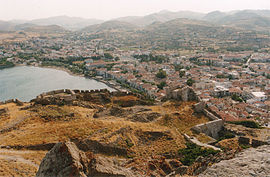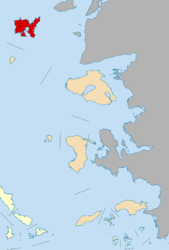Lemnos
|
Limnos Λήμνος |
|
|---|---|

|
|
| Coordinates: 39°55′N 25°15′E / 39.917°N 25.250°ECoordinates: 39°55′N 25°15′E / 39.917°N 25.250°E | |
| Country | Greece |
| Administrative region | North Aegean |
| Regional unit | Lemnos |
| Area | |
| • Municipality | 477.6 km2 (184.4 sq mi) |
| Highest elevation | 470 m (1,540 ft) |
| Lowest elevation | 0 m (0 ft) |
| Population (2011) | |
| • Municipality | 16,992 |
| • Municipality density | 36/km2 (92/sq mi) |
| Time zone | EET (UTC+2) |
| • Summer (DST) | EEST (UTC+3) |
| Postal code | 81400 |
| Area code(s) | 22540 |
| Vehicle registration | MH, MY |
| Website | www.limnos.gr |
Lemnos (Greek: Λήμνος, Limnos) is an island of Greece in the northern part of the Aegean Sea. Administratively the island forms a separate municipality within the Lemnos regional unit, which is part of the North Aegean region. The principal town of the island and seat of the municipality is Myrina. At 477.583 square kilometres (184.396 sq mi), it is the 8th-largest island of Greece.
Lemnos is mostly flat (hence its more than 30 sand beaches), but the west, and especially the northwest part, is rough and mountainous (highest elevation: Mount Vigla, 470 m). The chief towns are Myrina, on the western coast, and Moudros on the eastern shore of a large bay in the middle of the island. Myrina (also called Kastro, meaning "castle") possesses a good harbour, which is in the process of being upgraded through construction of a west-facing sea wall. It is the seat of all trade carried on with the mainland. The hillsides afford pasture for sheep, and Lemnos has a strong husbandry tradition, being famous for its Kalathaki Limnou (PDO), a cheese made from sheep and goat milk and melipasto cheese, and for its yogurt. Fruit and vegetables that grow on the island include almonds, figs, melons, watermelons, tomatoes, pumpkins and olives. The main crops are wheat, barley, sesame; in fact Lemnos was Constantinople's granary during Byzantine times. Lemnos also produces honey (from thyme-fed bees), but, as is the case with most products of a local nature in Greece, the produced quantities are little more than simply sufficient for the local market. Muscat grapes are grown widely, and are used to produce an unusual table wine that is dry yet has a strong Muscat flavor. Since 1985 the variety and quality of Lemnos wines have increased greatly.
...
Wikipedia


